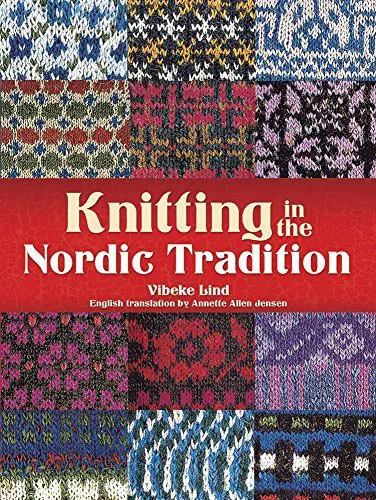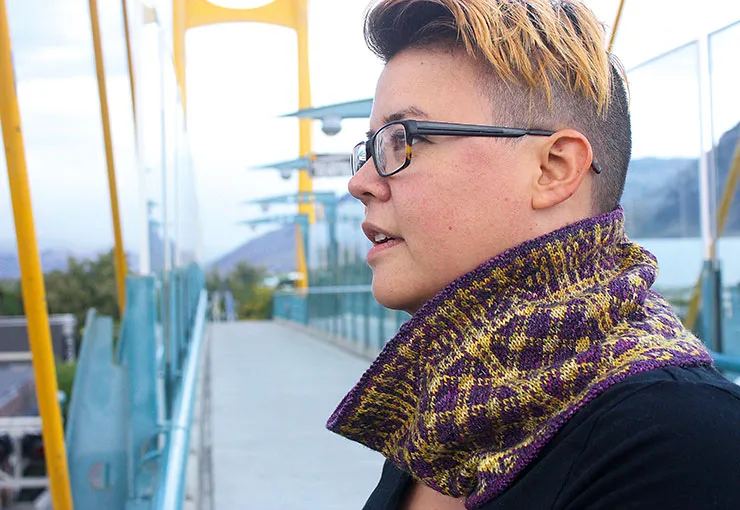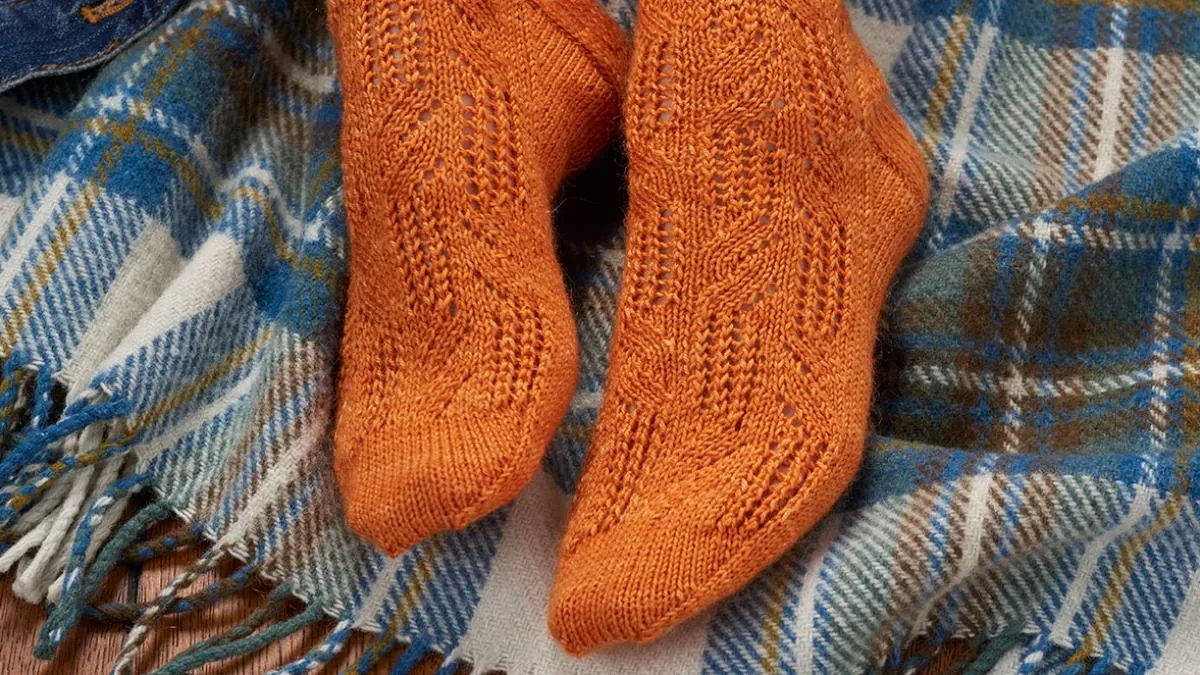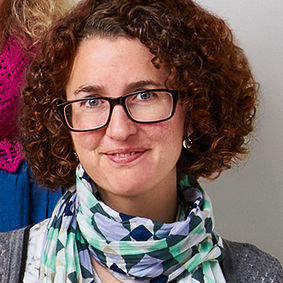Barb Brown, from Alberta in Canada, loves to create socks, bags, and other accessories influenced by folk textiles, and patterns inspired by the handknits of her Shetland-born great-grandmother. We chatted with Barb about her knitting life.
Who inspired you to take up knitting? "I grew up surrounded by women who knitted. It was just one more job women did. They knitted to keep their family warm, and to make a little extra cash on the side. I started to learn when I was around four years old, and sold my first hat when I was 12.
"It was around the same time that I began being interested in the history of my family, especially my great-grandmother Jeremina who came from the Shetland Islands. She emigrated to Canada in 1885, with her spinning wheel. My family still owned (and wore) sweaters she had made from her hand-spun, and there was even one of the cobweb shawls she had made.
"It fascinated me that the same person could spin the yarn and knit a warm sweater designed to keep a man warm on the ocean or in the bush and make it beautiful, and then almost in the same breath, spin such a fine soft yarn and knit an amazing lace shawl. I was hooked… knitting became an art and means of self expression."

Do you have a favourite artist, writer, poet or musician who inspires you? "Roberta Murray is an artist who has inspired me from the first day I met her. At the time, she was a spinning teacher. She also knitted, and painted her finished projects. She wove. She loved photography, and took it up as an art form, and made a name for herself. From there, she fell in love with painting and once again reinvented herself. I am lucky enough to own one of her paintings, and a print of one of her photos.
"We often talked about art, and women's work, and the economics of it all. One day we were discussing my designs, and she said, "Something like what you've done needs to be paid for, and it should be well paid for". Somehow, coming from her, it was like a huge kick in the pants! It gave me the courage to send off my first design submission. And whenever I lose my courage (which is common in those who create!), her words inspire me again, as does her courage in leaping in both feet to conquer a new inspiration. Add in the beauty of her paintings, which inspire me with their colour and her depiction of a country I love, and that's just about the perfect inspiration and mentorship."
Which knitwear designer has most inspired you, and why? "Elizabeth Zimmermann, hands down. Until I discovered her books, I felt guilty when I changed a pattern! I would design my own sweater, but almost had a feeling it wasn't a legitimate design because it didn't come from a book. Elizabeth's Knitting Workshop book changed all that. It was as if I had been given a licence to change things, and received a degree in designing. It quite literally set me free to express myself with yarn.
"To this day, when I teach any knitting class, at some point I will tell my students: "You have an official license to change things." I even put that exact phrase in my book. I've always wished I had had the opportunity to meet her."
Tell us about the colours, landscapes or architecture that inspire your design work. "There is really no one thing that inspires me – inspiration is everywhere. Right now, for example, I have ideas I'm working on… a shawl inspired by a painting of Paris in the rain; a wrap inspired by a dream I had of dancers on a hilltop in a thunderstorm, dancing to transform the lightning; a coatigan in Icelandic lopi inspired by old embroidery patterns; a heavy, sturdy, outdoor sweater in a Cowichan style with Ukrainian Easter Egg patterns. Inspiration comes from dreams, from paintings, scenery, history, stories, and sometimes is born fully fledged in my brain in an instant."

What is your favourite knitting book of all time? "I think it would have to be Knitting in the Nordic Tradition by Vibeke Lind. There is so much information in this book, and it always inspires me to try something new, and to play with the technique and see if I can make it different and my own. Knitting is a living thing. If we don't grow it, and make it our own, and experiment, it becomes static and boring."
What fibres do you love to work with? "My favourite fibre is wool… pure wool that isn't over processed. I enjoy the different characteristics of the yarn spun from the many sheep breeds. I am fascinated that I can find the perfect pure wool for almost any project: sturdy socks, soft baby sweaters, drapey shawls, hard-wearing work clothes. And for children and workwear I love that wool is inflammable, and still keeps you warm when it's soaking wet. I do enjoy working with other fibres and blends, but nothing really beats wool."

Which design from your portfolio are you most proud of, or is most special to you? "This is a really tough question! I finally had to settle on two. I am proud of both, and they are both special, but the reasons are totally different. First is 'Roadsidea'. (The name comes from flowers along the roadside.) I saw a nature-dyed wool from Elderberry Yarns, and I had a vision of the socks I wanted to make with it, almost as if they were hanging in the air above the yarn. I've experienced this before, but these had a stitch I'd never seen! I had to experiment and do a lot of ripping out before I achieved the effect I was looking for. And then I had to work on it to make it knitter friendly. I always think knitting should be fun!
"The other is 'Seraglio'. I grew up surrounded by strong women who fought hard to be treated as equals. I have been around long enough to remember when a woman could be told, "We won't hire you because you are a woman." Over the past 10 years, there have been attempts to erode the rights we've achieved, and this both angered and frightened me. I wanted to design something that spoke of my feelings. The romance for this pattern reads: "The colourwork motifs are adapted from Turkish stocking patterns: the bottom motif shows earrings and butterflies representing the luxuries behind the Seraglio walls; the middle portion symbolizes the lattice, the screen between women and the outside world; and at the top are the hooks, representing how difficult it is to get out once a woman agrees to go in. The sparkling yarn is the beautiful, exciting world beyond."
Are there any techniques or styles of knitting you'd like to explore further? "Lately, I've been fascinated by the traditional zigzag patterned mittens from Rovaniemi, Finland, and the Roositud technique from Estonia. I've been playing around with them, and exploring what can be done with them and their differences and similarities. I have an idea boiling in my brain that involves both, and is inspired by one of my favourite Ukrainian Easter Egg designs. I'm not sure where it's all going to take me!"
See more of Barb's work on www.ravelry.com/designers/barb-brown

